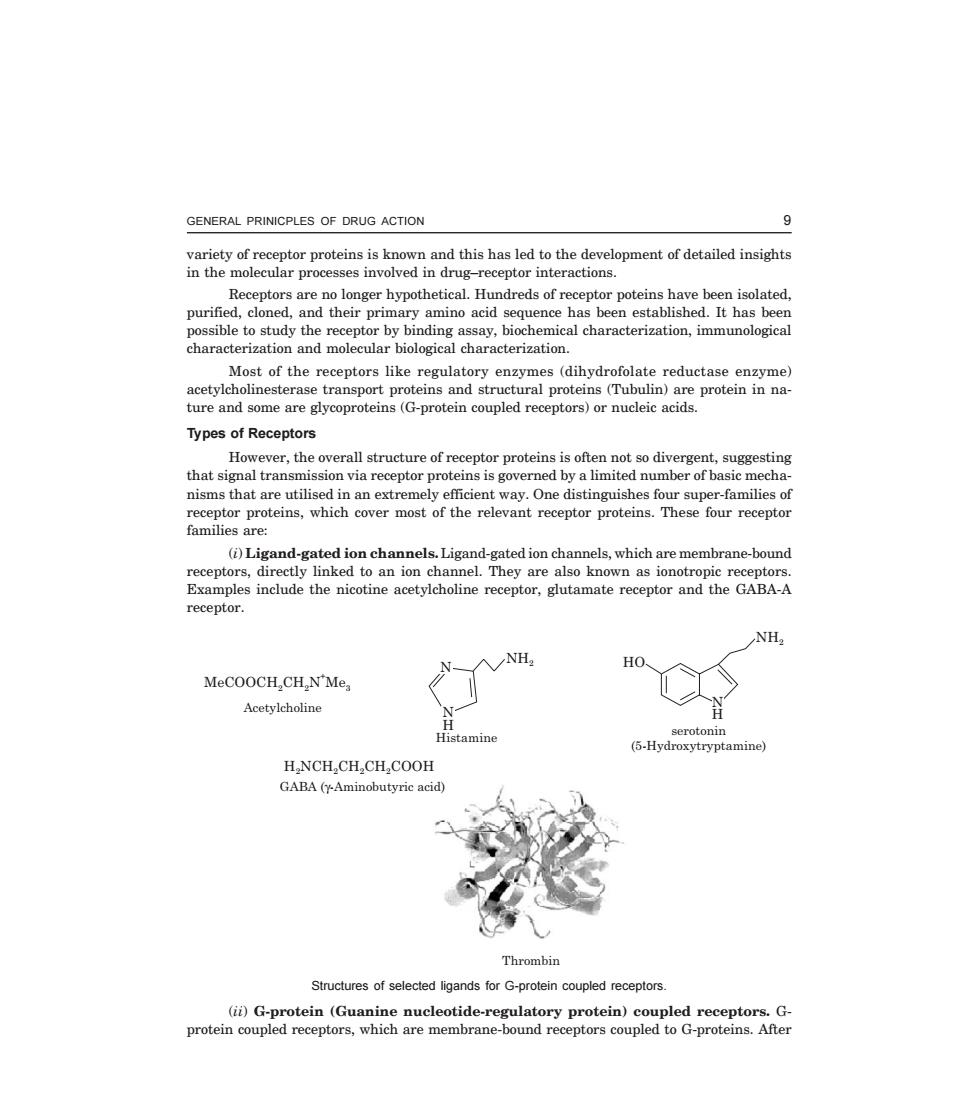正在加载图片...

GENERAL PRINICPLES OF DRUG ACTION 9 lar proces Receptors are no longer hypothetical.Hundreds of receptor poteins have been isolated, purified,cloned,and their primary amino acid sequence has been established.It has been possible to study the receptor by binding assay,biochemical characterization,immunological characterization and molecular biological characterization. Most of the receptors like regulatory enzymes (dihydrofolate reductase enzyme) acetylcholinesterase transport proteins and structural proteins (Tubulin)are protein in na- ture and some are glycoproteins(G-protein coupled receptors)or nucleic acids. Types of Receptors However.the overall structure of receptor proteins is often not so div that signal transmission via receptor proteins is governed by a limited number of basic mecha nisms that are utilised in an extre emely efficient way.One distinguishes four super-families of receptor proteins,which cover most of the relevant receptor proteins.These four receptor families are edionchannels.Liga ae nd-gated ion channels,which are membrane-bound cep d t an e les ion own as i the GABA-A receptor NH NH HO. MeCOOCH,CH,N'Me Acetylcholine (-ymn) HNCH,CH,CH,COOH GABA (Am outyrie acid Thrombin Structures of selected ligands for G-protein coupled receptors (ii)G- e nucleotide. regulatory protein)e G are mem receptors coupled G-proteGENERAL PRINICPLES OF DRUG ACTION 9 C-8—N-CHEMI\CHE2-1.PM5 variety of receptor proteins is known and this has led to the development of detailed insights in the molecular processes involved in drug–receptor interactions. Receptors are no longer hypothetical. Hundreds of receptor poteins have been isolated, purified, cloned, and their primary amino acid sequence has been established. It has been possible to study the receptor by binding assay, biochemical characterization, immunological characterization and molecular biological characterization. Most of the receptors like regulatory enzymes (dihydrofolate reductase enzyme) acetylcholinesterase transport proteins and structural proteins (Tubulin) are protein in nature and some are glycoproteins (G-protein coupled receptors) or nucleic acids. Types of Receptors However, the overall structure of receptor proteins is often not so divergent, suggesting that signal transmission via receptor proteins is governed by a limited number of basic mechanisms that are utilised in an extremely efficient way. One distinguishes four super-families of receptor proteins, which cover most of the relevant receptor proteins. These four receptor families are: (i) Ligand-gated ion channels. Ligand-gated ion channels, which are membrane-bound receptors, directly linked to an ion channel. They are also known as ionotropic receptors. Examples include the nicotine acetylcholine receptor, glutamate receptor and the GABA-A receptor. MeCOOCH CH N Me 22 3 + Acetylcholine H NCH CH CH COOH 2 222 GABA ( -Aminobutyric acid) γ Histamine serotonin (5-Hydroxytryptamine) Thrombin N N H NH2 HO N H NH2 Structures of selected ligands for G-protein coupled receptors. (ii) G-protein (Guanine nucleotide-regulatory protein) coupled receptors. Gprotein coupled receptors, which are membrane-bound receptors coupled to G-proteins. After